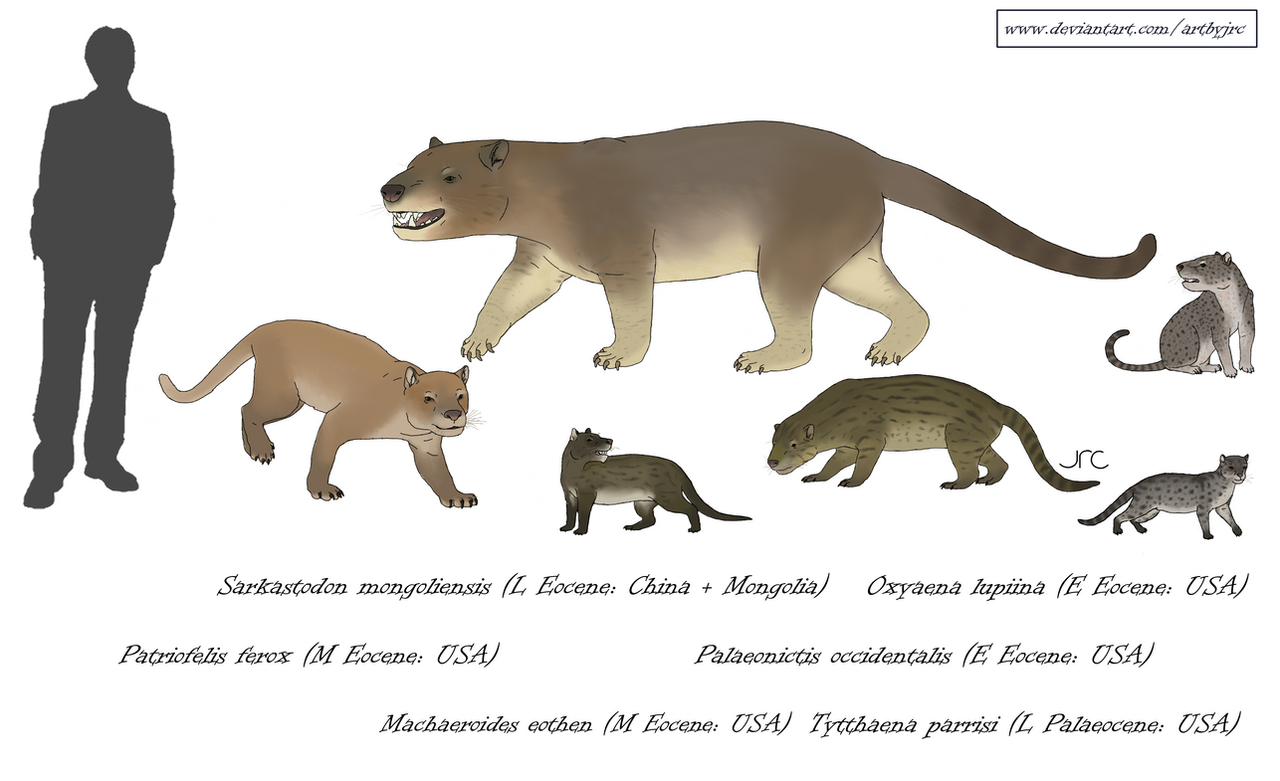HOME | DD
 artbyjrc — Pseudo-felids (sort of) - Oxyaenids
artbyjrc — Pseudo-felids (sort of) - Oxyaenids

#carnivora #cat #predator #creodont #machaeroides #patriofelis #oxyaenid #oxyaena #sarkastodon #palaeonictis #tytthaena #carnivore
Published: 2020-06-01 11:32:37 +0000 UTC; Views: 17218; Favourites: 252; Downloads: 81
Redirect to original
Description
A selection of the extinct carnivorous mammals known as oxyaenids, to scale.
Some fossil species have the misfortune of looking vaguely familiar, but in other ways like nothing else. Within the mammals, this is most apparent in those early species which have primitive features. While resemblimg one taxa, a species might actually belong to a totally different group. If they don't fit obvious groupings, then difficult species usually end up in 'wastebasket' groups. Two notable wastebasket groups are the herbivorous condylarths and the carnivorous creodonts. Membership to each group has swelled and shrunk over time with better knowledge. Now reassigned to other groups are the miacids (stem carnivorans), arctocyonids (now split between various groups) and mesonychians (often considered stem ungulates). Left remaining under the 'creodont' banner were the hyaenodonts and the oxyaenids. Both groups don't really show any commonality of features beyond having carnassial teeth which they also share with carnivorans. Not a ringing endorsement for relatedness. So what is the modern consensus? Well there isn't really one. Many of the old 'creodonts' have been loosely linked up again under the Ferae banner which also includes carnivorans and the pholidota (pangolins).
Oxyaenids are not a diverse group and can be described as being more cat-like, compared to the dog-like hyaenodonts, with a fair amount of mustelid about them too (otter-like is often mentioned). They include some of the earliest large mammalian carnivores across North America and into Eurasia, with fossils found between the Late Paleocene and the Late Eocene. Skulls are short, broad and robustly built, strongly muscled to provide a tremendous bite force. Their teeth were designed for crushing rather than cutting (convergent with hyaenas). Although not fast hunters, their feet were broad which would have allowed them to creep silently while some species were capable of climbing into trees. While most oxyaenids were general carnivores, the teeth of Palaeonictis suggests their diet was more omnivorous. One specialised subfamily includes the small Machaeroides. With elongated sabreteeth they were probably capable of hunting prey much larger than themselves. The largest and last known species was Sarkastodon, an apex predator in Eastern Asia. Known only from one large skull, there has been much debate as to the actual total size. Some estimates come in at an impressive 800 kgs, but these figures are way out as oxyaenids have large heads compared to their body. When based on skeletals of the related Patriofelis, the true size of Sarkastodon is probably between 200-300 kgs (well within Siberian/Amur tiger range).
Related content
Comments: 45

👍: 2 ⏩: 1

👍: 0 ⏩: 0

👍: 2 ⏩: 1

👍: 1 ⏩: 1

👍: 0 ⏩: 0

👍: 2 ⏩: 0

👍: 2 ⏩: 1

👍: 2 ⏩: 0

👍: 1 ⏩: 2

👍: 1 ⏩: 0

👍: 1 ⏩: 2

👍: 1 ⏩: 1

👍: 0 ⏩: 0

👍: 1 ⏩: 1

👍: 0 ⏩: 1

👍: 1 ⏩: 1

👍: 1 ⏩: 0

👍: 1 ⏩: 1

👍: 2 ⏩: 1

👍: 1 ⏩: 1

👍: 1 ⏩: 1

👍: 1 ⏩: 1

👍: 0 ⏩: 1

👍: 1 ⏩: 0

👍: 1 ⏩: 1

👍: 1 ⏩: 0

👍: 2 ⏩: 1

👍: 1 ⏩: 0

👍: 2 ⏩: 1

👍: 1 ⏩: 1

👍: 0 ⏩: 1

👍: 0 ⏩: 0

👍: 2 ⏩: 1

Doubt the increase in prey size had to do with temperature, as things continued to get colder throughout the Cenozoic but it wasn’t automatically correlated with animal size.
👍: 1 ⏩: 1

👍: 0 ⏩: 1

With Pleistocene megafauna there really isn’t a general trend towards colder climates: all the megafauna lived through multiple glacials AND interglacials, and many were actually more suited to the interglacials.
👍: 1 ⏩: 0

👍: 1 ⏩: 0

👍: 2 ⏩: 1

👍: 1 ⏩: 0
























